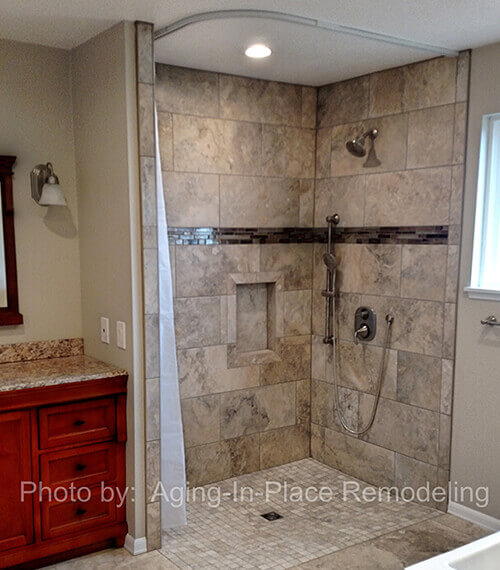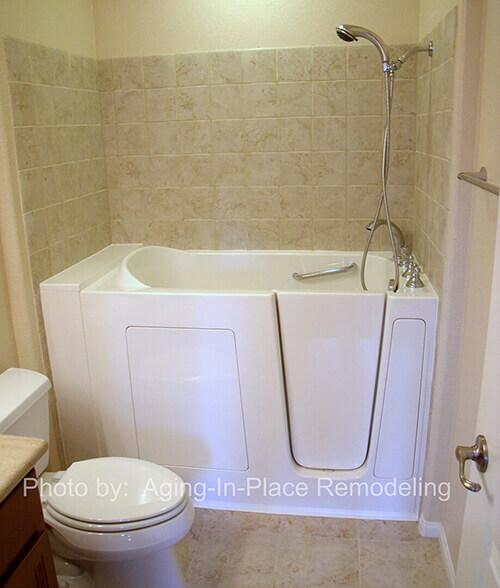Accessible Bathrooms
Bathrooms are considered the most dangerous room in the home. More injuries are caused in that one room than the rest of the home combined. When you consider the high thresholds on bathtubs, the slick floor tile, the poor lighting, it is no surprise. But there are solutions available to take the dangers out of using the bathroom.
There are hundreds of products available to create a safe and confidence-inspiring bathroom. From simple fixes such as grab bars, bath seating, and bath lifts to more elaborate projects such as walk-in tubs, comfort-height toilets, and removal of thresholds.
Aging-In-Place does hundreds of accessibility projects every year. We are asked to address some issue in the bathroom on about 90% of those projects. Our vast experience and huge product catalog will surely be able to provide you with a more accessible and comfortable bathroom.
Call The Professionals at Portland Accessibility Remodelers Today!
Bathroom Accessibility projects can include:
- Walk-in Bathtubs
- Accessible Showers
- Tub-to-Shower Conversions
- Add-on Accessories
Accessible Showers in Portland

Are you looking for a home modification that can make showering more comfortable and safer? Our dedicated professionals at Portland Accessibility Remodelers can help you find the solution to have relaxing showers once more.
What are Accessible Showers?
Conventional showers can be a potential hazard if you are thinking about aging-in-place. A standard shower threshold can be difficult to step over, and the slick surface of many conventional shower stalls can lead to dangerous slips or falls.
Installing an accessible shower or converting an existing shower stall can lower your risk for accidents in the shower. It can also make independent bathing safer.
The design of accessible showers considers both the safety and the ease of use for the bather. Converting an existing shower can be a cost-effective way to ensure safer showering. If space allows, modular accessible showers can fit into your existing bathroom. These modular showers have many standard safety features, like low entry ledges and built-in shower seats.
There is a wide range of styles available, making it easy to find one that will match the existing look of your bathroom. There are also accessible shower options if you use a wheelchair.
Barrier-free showers with removable thresholds or collapsible water dams can help those in a wheelchair position themselves in the shower. Another option is a transfer shower. A transfer shower allows for easy transfer from a wheelchair to a shower seat. Alternatively, roll-in showers feature wider entryways and beveled thresholds, allowing a wheelchair to roll directly into the shower.
If you already have a shower stall in your bathroom, we can convert an existing shower. Professionals can convert an existing shower by lowering the height of the shower’s entry threshold or using a removable threshold. They will also install grab bars in and around the shower and cover shower floors with non-slip flooring materials. These modifications can lower the risk of accidents and make you feel more secure when taking a shower.
Additional options to consider when thinking about installing an accessible shower:
Are you ready to make showering more enjoyable and safer? Contact the professionals at Portland Accessibility Remodelers to explore accessible shower options.
Walk-In Tubs in Portland

Bathrooms are a common location of dangerous slips and falls. Portland Accessibility Remodelers can help make your bathroom a safer place.
A walk-in bathtub can be a safe solution to this challenge. With a walk-in bathtub, you can avoid the potential dangers of a traditional tub while still enjoying a relaxing soak.
What is a Walk-In Tub?
Walk-in tubs are bathtubs with a watertight door. To enter, you step into the tub over a low threshold. After closing the door, the bathtub fills with water for the bath. When you’ve finished bathing, the water drains from the tub, after which you can open the door and exit the tub.
While walk-in tubs are deeper than traditional bathtubs, they tend to be narrower in width. Many walk-in tubs use less water than a standard bathtub, averaging about 50 gallons of water per filled tub versus up to 80 gallons for a standard tub.
Advantages of Using a Walk-In Tub
There are several advantages of opting for a walk-in tub if you have balance or mobility issues. Most tubs come complete with essential safety features.
Some of the safety features included are built-in handrails and contoured seating, anti-slip flooring, a low step for entry, and anti-scald valves. Walk-in tubs can provide several health benefits for the bather.
- Soaking in hot water can alleviate joint aches and pains. It can also speed the healing of injuries like burns and ulcers.
- If the tub comes with optional hydrotherapy jets, you can receive the muscle-relaxing effects of a traditional outdoor hot tub. There are also models available with wider doors that can swing outward to accommodate wheelchairs.
- These wider doors allow wheelchair users to transfer safely and independently from their wheelchair to the tub seat. There are also bariatric-sized tubs are available for those who need a larger tub.
- You can also use walk-in tubs as showers. Specific models come with extendable shower heads that allow you the ease of a shower, either standing or seated.
- Some tub models even have a riser rod that emulates an actual shower.
Options to Consider When Thinking About Installing a Walk-In Tub:
Before deciding to install a walk-in tub in your home, it’s crucial to think about a few things, like:
